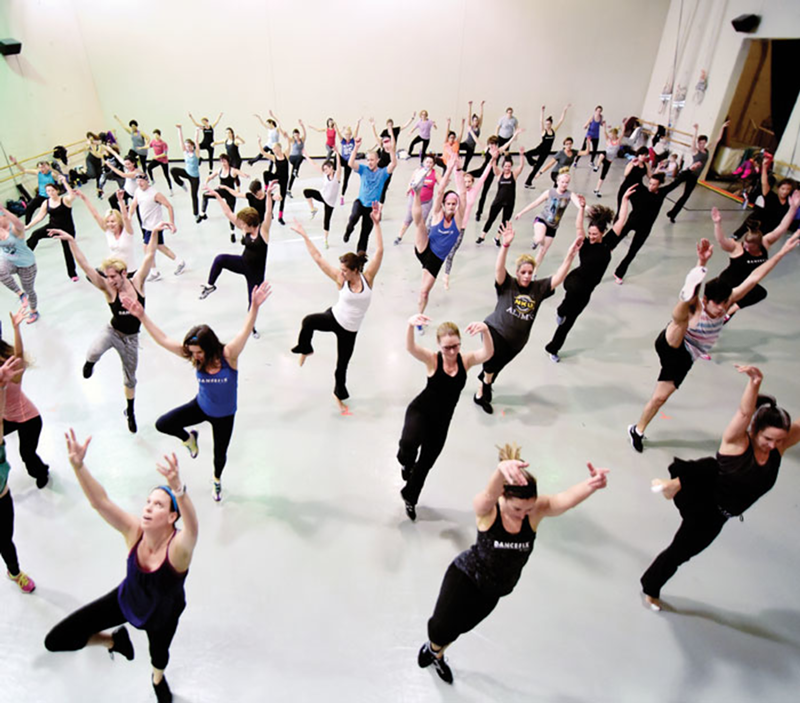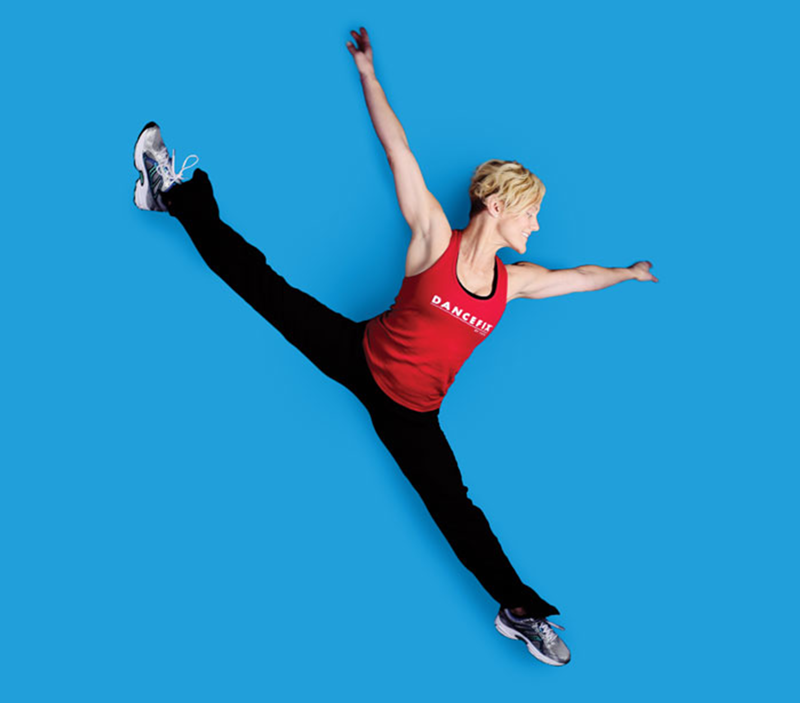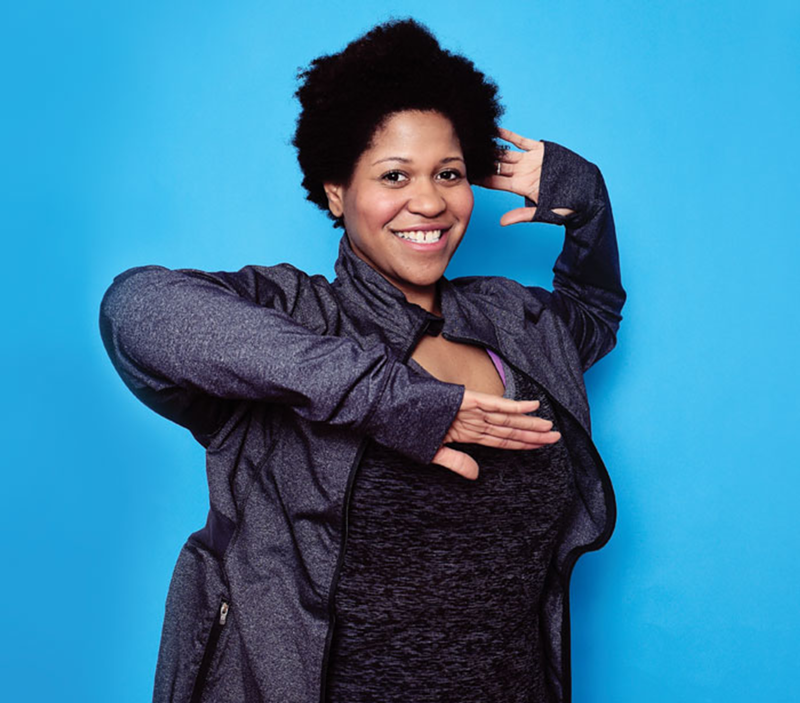Walking into a DANCEFIX class at the Cincinnati Ballet center on a Saturday morning is a bit like walking into a mid-summer tent revival. The air is humid and slightly salty from the evaporated sweat of a previous workout; little kids in pink leotards buzz around the lobby while parents try to catch them and stuff them into jackets; and an unexpected velvet-gray French bulldog comes bounding out of nowhere, chasing a ball. Among the riot of color and activity stands a line of eager patrons, ready to check in and walk through a large set of double doors and into a temporary sanctuary — in this instance, an hour-long dance class which will soon be reverberating with the sounds of Samba beats, loosely synchronized tour jetés and loud, exultant cheers.
By 11 a.m., around 65 people have crossed the threshold and are whirring and mingling inside the studio, a sort of mirror-walled gymnasium, casually staggered and waiting for DANCEFIX instructor Heather Britt. The students are a rainbow connection of ages, sizes, colors and genders, a Seurat fever dream of patterned spandex, stretching and shaking out their feet in Nikes and split-sole dance shoes. Some are even donning HBDC-branded T-shirts and tanks, for the Heather Britt Dance Collective, the umbrella organization that oversees DANCEFIX and a handful of other Britt-produced dance technique classes, including theater Jazz, West African dance and even Hawaiian hula.
As Britt enters and moves to the front of the room, instead of igniting the dramatics of a wailing faith healer clutching at snakes, she simply turns on the stereo. Her flock is waiting, anxious to learn some new choreography and get the party started.
Her energy is palpable but unassuming without a hint of ego or vanity. Blonde and dressed for a workout, Britt is technically there to lead the class, but you can tell she’s also there to dance, really dance, not just walk around and tell you what to do. And when she opens her mouth to speak — shout actually, to address the entire room — she asks if it’s anyone’s first time. And, if you’re me — a person who isn’t coordinated enough to safely walk while carrying a cup of coffee and is securely hidden in the very back corner — you sheepishly raise your hand. And then, like a slow-motion nightmare, everyone turns and stares at you, and then erupts into a startling round of warm applause and joyful welcome; you’ve been initiated.
• • • • • • • • • • • • • • • • • • • • • • • • • • • • • • • • •
“People joke that it’s a cult; it’s really intense that way,” Britt says, laughing.
Britt has been teaching some version of a dance aerobics class locally since 2000, when she returned to Cincinnati after a decade-long stint in San Francisco. A graduate of the School for Creative and Performing Arts with a dance background in everything from ballet to jazz, she had been dancing professionally on the West Coast, mostly for modern contemporary companies, and also teaching a class called Rhythm & Motion. When she decided to move back home, Consuelo Faust, owner of Rhythm & Motion, asked her to bring the program with her. She did and began teaching at locations including TriHealth in Blue Ash, GE, Contemporary Dance Theater and eventually the Cincinnati Ballet.
Many of Britt’s students have been with her since the first iteration of Rhythm & Motion at TriHealth. But in 2014, Britt branched out to start her own program, DANCEFIX, with the ballet studio on Central Parkway acting as a hub. In October of last year, she opened a second location in Blue Ash, across from the new Sleepy Bee, to broaden the reach of the program and also incorporate her additional dance offerings.
DANCEFIX is a high-energy dance class that pairs 10 songs with 10 different pieces of choreography, increasing in cardio intensity as the hour progresses. “Basically, you get your fix — it kind of is addictive in that way — and you get fixed; it’s therapeutic,” Britt says of the name. Each week students learn one new choreographed dance while continuing to work on nine others. The music ranges widely in style, hitting on everything from Pop and Hip Hop from the likes of Missy Elliott and Adele to World Beat and Latin songs.
“They’re all highly choreographed by myself and the DANCEFIX teachers,” Britt says. “It’s meant to stay challenging over time, so the choreography is pretty challenging. It’s one of those commitments at first that can be intimidating, but it’s what keeps people coming back because they don’t get bored.”
Britt, also a full-time dance instructor at Northern Kentucky University and a freelance choreographer, has created a program and repertoire completely unlike any other dance-based aerobics class on the market.
“The thing that I like to say, and I don’t know if they’d be offended by this, but when talking about Zumba or Jazzercise, I think of them as an exercise class that uses dance,” she says. “And I think of what we do as a dance class that you happen to get a really insane workout doing.”
Pones Inc. dancer Ian Forsgren is a former NKU dance student.
“I’ve never personally experienced anything like it,” he says. “Like, I don’t know that there’s anything locally or even outside of the city to compare it to. It’s such an experiential thing.”
Forsgren is one of 10 DANCEFIX instructors, all from different dance backgrounds and all of whom completed Britt’s three-month intensive training program. Between them, they teach 26 classes per week at the Cincinnati Ballet and Blue Ash studio, reaching about 2,400 students per month.
“I hated it at first,” says Leyla Shokoohe, communications coordinator at ArtsWave (and occasional CityBeat contributor) who now volunteers her time doing social media and PR for DANCEFIX. “I was so angry that I couldn’t catch onto the choreography. But why would I be able to? It’s not like I ever danced an iota in my life before then, but I kept going.”
And the choreography is challenging — much more challenging than your typical step-touch, step-touch routine; more like ballet meets club breaks meets tribal. There’s even a portion of class where you dance around the room in a choreographed circle, like a manic Where the Wild Things Are rumpus.
“The energy generated by people coming together and moving in and out and around the center of a circle is so powerful, explosive and contagious,” Britt says. And she’s right. Instead of looking at yourself in the mirror or the backside of the person in front of you, you’re actually dancing together as a group and looking each other in the eye. It’s a judgment-free dance party.
But if you’re a Type A personality who needs to do things correctly, Britt and her teachers do offer intermittent, free half-hour choreography instruction classes so you can perfect your pirouettes and learn how to whip/nae nae. But it’s also totally OK to just bop and flail around; Britt says she’s even had some students come and just stand in the back and sing. “If people are doing their own thing, that’s what it’s all about,” she says.
Dominique Brown, assistant director of the University of Cincinnati’s University Honors Program, agrees. She began taking DANCEFIX about three years ago.
“Many people in the class have been dancing for a while, but they were truly so encouraging and welcoming that even if I didn’t know the steps, it was easy to just jump around, sweat and enjoy myself,” she says, remembering one of her first classes. “Since I grew up dancing as a child, it was kind of like being reminded of something that had been missing from my life. There was a Beyoncé song that I remember dancing to even to this day, I just remember leaving feeling so happy and alive.”
• • • • • • • • • • • • • • • • • • • • • • • • • • • • • • • • •
The mission of DANCEFIX is to create health, happiness, connection to yourself and connection to your community through dance, Britt says. “I feel like, when we’re looking at the class, I’m really looking at it from an artistic purpose instead of a fitness purpose,” she says. “I know we’re building on our cardio and we’re all getting a great workout, but when I’m choreographing the dance, I’m not necessarily thinking, ‘What is my heart rate going to be doing right now?’ It’s definitely dancing for the joy of it and not worrying about anything else besides that.”
That being said, it is an intense workout. Both Brown and Shokoohe said they lost pounds in the double digits after regularly attending. “Heather does not think of DANCEFIX as a way to get skinny,” Shokoohe says. “It’s not about getting fit, although that is a lovely by-product.”
As Britt and her teachers see it, DANCEFIX is really about joy and community, and those tenets manifest in a variety of ways. There’s literally the physical community that assembles for class — a huge cross-section of Cincinnati that comes together to dance and sweat it out — but there’s also the myriad flash mobs and work with nonprofits Britt and her students do. It’s a great equalizer, Shokoohe says. There’s no test to pass to get into class: As long as you have $15, you can just drop in and move.
And that’s one of Britt’s favorite aspects of the program. “The main thing I think happens in the room is you have people that maybe would never cross paths. So you have someone who’s an artist or someone who’s waiting tables and someone who works in a school, people that are doctors, different professionals, stay-at-home moms, and they’re all crossing paths and making connections because dance is their connection,” Britt says. “They’re connecting because they have a common ground, which is that they like to dance. But it gets deeper than that. I feel like when I talk about it too much, I’m going to make it cheesy. I feel like it happens so organically, it’s one of those things that if I market it too much then it’s going to ruin it. It just happens and it’s pretty awesome.”
And that’s one of the reasons students joke that DANCEFIX is cult-like. It’s infectious, Forsgren says, and friendly and supportive. It’s a group of people from all different walks of life coming together to express themselves and dance and sweat and boost their serotonin levels. And it’s for this reason DANCEFIX students develop deeper relationships than your average gym buddies.
“We’re seeing these big life changes as these students have been coming,” Britt says. “I mean, the students that have been coming to these classes, some have been coming since my very first class I started in 2000. So you’ve seen them transition from losing loved ones, and watching them, they do process that through class. They’re experiencing life, and the dancing is helping them to kind of work through it with their bodies; it helps to get out of their heads and into their bodies and process things without over-thinking.”
Brown says: “It is definitely something that has helped me deal with regular stress and many things that have come my way over the past few years. I lost my mother to cancer shortly after starting DANCEFIX, so it was definitely something that helped inform my grieving process. … It has done so much for my physical and mental health overall.”
Anita Dock, a local dietician, has been an avid DANCEFIXer for at least a decade, following Britt and her teachers from TriHealth to College Hill to downtown and back. She has a background in theater and dance and still dabbles in local theater, and she finds that DANCEFIX connects her to the arts in a creative, expressive way that is both mentally and physically challenging. And when Dock was diagnosed with breast cancer in 2008, she really relied on the DANCEFIX community.
“When I was going through my cancer treatment, it helped me with all of these,” Dock, now in remission, says. “It was also something that I could do for me, because with cancer treatment you can just pray your chemotherapy is going to work, but you don’t have a very hands-on way to deal with it, so for me personally, this gave me a chance to connect to that.”
She talks about finding the courage to go to class without hair, wearing different long, colorful scarves twisted up into a bun like a prima ballerina, and the outpouring of support. One of the uniting factors of DANCEFIX students seems to be a shared dislike of traditional exercise, but Dock says friends from class would come work out with her at the gym after surgeries when she wasn’t allowed to jump around. One classmate even took her head measurements and hand-knitted her a hat. Another made her earrings.
“I think I was working out more than I do now,” Dock says of her time during treatment. “I think I was there five days a week and it really helped my energy level and all the other things that that class is about. It gave me my connection, my affiliation. It still gave me my structure, the connecting to everybody, the support, it was everything.”
“As a dietician, I try to teach — I obviously want my patients to exercise for physical and mental health — but I also teach in my practice how your life has to have balance,” she continues. “And people define balance differently, but in my practice, I have 11 things that a person needs to have in a good, even amount in order to feel that sense of balance.”
For her, DANCEFIX meets all requirements, from self-esteem and structure to spirituality, exercise, intellectual stimulation and affiliation. The community aspect is also something she stresses to her patients, whether it’s going out together to see a dance performance Britt choreographed, hanging out before class or participating in a flash mob.
Flash mobs are a big thing for DANCEFIX; Britt has been doing them at fundraisers and parades since the beginning. And they’re a big community activation tool and a way to engage, Shokoohe says. The flash mobs started partially as a means for students to publicly show off their choreography at events like the Northside Fourth of July Parade, but soon spiraled into getting the party started for different nonprofits, like Caracole or People Working Cooperatively. They even did a flash mob on Fountain Square during the All-Star Game.
This year, Britt hopes to possibly transition to a flash-mob-for-donation model to help build a fund for DANCEFIX scholarships. “We have all ages, we’re diverse as far as men and women — we have more men than we used to do — we have racial and cultural diversity,” she says of the class. “But it’s not a cheap class. So you have the socioeconomic, that’s the diversity piece we’re missing. If we’re going to represent the community, we should represent it all.”
She and her students and teachers frequently volunteer and do outreach at women’s shelters, off-the-streets programs and at places like the Anna Louise Inn.
“We’ll go and teach them for a day about body awareness, just being in your body, and we’ll take a dance class with them,” Britt says. “And you always have a couple of women you can tell are really like, ‘Yeah. This is what I want.’ And I think it would be nice to say, ‘Oh we actually have a fund and so now here’s 10 classes so come over to the ballet.’ ”
• • • • • • • • • • • • • • • • • • • • • • • • • • • • • • • • •
In 2014, DANCEFIX applied for ArtWorks’ Big Pitch competition/mentorship program for local creative entrepreneurs, where winners receive up to $20,000 in small business grants. While Britt didn’t win, the program helped her focus and organize her vision for HBDC and DANCEFIX.
“I do feel like the reason that DANCEFIX is so successful is that I’ve been really passionate about it from the beginning,” she says. “I love it, but I also think it was so successful because it wasn’t marketed as this big business at first. It really was ‘everybody just come,’ and it built over time as this word of mouth. A dance party. And it feels like that.”
Before the Big Pitch program, DANCEFIX literally didn’t have a website. It was fully grassroots. That is possibly the reason why her students feel such ownership over the class and such a sense of intense community; it’s their passion that grew the business.
“(My students) have supported every move I’ve made,” Britt says. “They’ve supported everything that we’ve done.”
DANCEFIX continues to grow. Britt says she’s seen a bump in attendance since 2014 and with the opening of the Blue Ash studio — she was afraid the additional location might dilute the experience, but she’s seen the exact opposite effect. And going to class has almost become a fad with local thirtysomething ladies. People extoll the benefits of DANCEFIX at bars and art openings; it’s like CrossFit for creatives, with just as rabid a fanbase.
Britt says she has gotten plenty of requests from former students who’ve moved away to spread DANCEFIX to other cities, and there has been some interest in franchising the brand. She’s had requests to make classes for kids and lower-impact classes for older adults or those with injuries. But for now, DANCEFIX is staying as is and growing organically.“In the 21st century, I think there’s such a push to take a model that’s worked really well and recreate it as much as possible to gain as much revenue as possible, and also to share that joy or whatever makes that product special with a bunch more people,” Shokoohe says, “but I also don’t think we have to do that. There’s something to be said for a unique business model that exists just as itself. And I really don’t think there would be that magic without Heather.
“She’s the thing — she’s that glue, that unifying factor — in DANCEFIX. We love her. She is our cult leader. There’s something very magnetic about her. She calls to us. She lets us be who we are. She takes somebody like me, a lump of clay before I started actively moving, and she’s like, ‘No. You come to my class. You’re just the same as this ex-ballerina. You’re just the same as these Ben-Gal cheerleaders. You’re just the same as these people. You have the same desire to move within you. You have the same desire to express yourself in a way you maybe haven’t been able to. Come to me. I’ll help you.’ ”
For more information on DANCEFIX or other HBDC dance classes, visit dancefixcincinnati.com.







